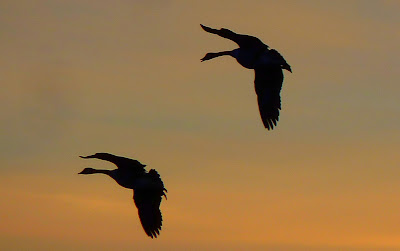I'd recently heard that hundreds of Canada geese have been gathering on the Superior Drive pond. Having taken a vacation day today, I was free to wander over that way as the sun was setting about an hour ago to see for myself.
Here's a view (above) of the east end of the pond, covered with geese and a few mallards. While I was there, many birds took to the air. Click on the photo below for a larger view of many dozens of geese in the air while dozens remain in the west end of the pond.
Here's a closer view (above).
The Cornell Lab of Ornithology says of the cackling goose:
Formerly considered the smallest subspecies of one variable species [i.e., the Canada goose], recent work on genetic differences found the four smallest forms to be very different. These four races are now recognized as a full species: the Cackling Goose. It breeds farther northward and westward than does the Canada Goose.
There was a lovely milky sunset against which the skeins of airborne geese could be seen in silhouette. My camera battery was running low, so I turned for home.







